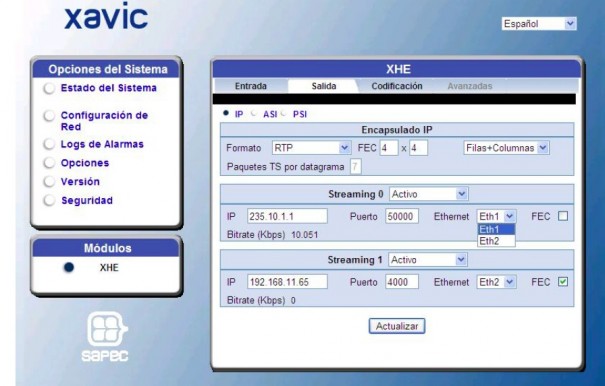Sapec presentará en NAB codificadores con perfil de contribución H4:2:2P para H.264 en SD y HD
Con la implementación de este perfil, la gama de productos Xavic se convierte en una solución completa para cubrir las necesidades de contribución y distribución de operadores de telecomunicaciones y cadenas de televisión, ya que pueden realizar compresión tanto en H.264 como en MPEG-2 con perfiles 4:2:0 y 4:2:2 en definición estándar (con señales analógicas y digitales) y alta definición.
Sapec presentará en NAB 2011 en Las Vegas (EEUU) del 11 al 14 de abril sus nuevos modelos de la familia Xavic, codificadores y decodificadores multiformato (H.264/MPEG-2) en definición estándar y alta definición, con perfil de contribución H4:2:2P para H.264 en SD y HD.
Con la implementación de este perfil, la gama de productos Xavic se convierte en una solución completa para cubrir las necesidades de contribución y distribución de operadores de telecomunicaciones y cadenas de televisión, ya que pueden realizar compresión tanto en H.264 como en MPEG-2 con perfiles 4:2:0 y 4:2:2 en definición estándar (con señales analógicas y digitales) y alta definición.
Los modelos que se presentan en la feria incluirán la versión 3.0 de los algoritmos de compresión desarrollados por Sapec, lo que permite reducciones del 15% del bitrate para la misma calidad de imagen. Para ello se ha incorporado la posibilidad de tomar imágenes B (imagen obtenida predictivamente con otras anteriores y posteriores) como referencia para futuras imágenes predictivas. Además, se ha conseguido reducir el retardo en la transmisión: un 10% en H.264 y un 30% en MPEG-2.
Se ha introducido también el modo de codificación con bitrate variable (VBR) en H.264, lo que permite ajustar la tasa de codificación a la complejidad de las imágenes.
Otra importante mejora es la incorporación de tres tipos de pre-procesado de video: compensación temporal (MCTF), configurable en cinco niveles; filtrado espacial, configurable en cinco niveles; y filtrado de frecuencia
Cada uno de estos filtrados es seleccionable a voluntad del usuario, de manera que es posible aplicar uno, dos, tres o ninguno de los tipos de pre-procesado disponibles.
Por otro lado, si bien los equipos Xavic mantienen perfectamente la sincronía entre el audio y el vídeo, es posible compensar retrasos presentes en la señal de entrada introducidos por elementos externos realizando en el codificador desplazamientos tanto en frames, hasta un máximo de 3, como en tiempo, en un rango entre -100 y +50 mseg en pasos de 1 mseg.
La interfaz IP de los equipos Xavic ha sido mejorada siendo ahora resistente a redes con muy alto jitter (variación en la tasa de recepción de paquetes IP). Dicho interfaz IP sigue teniendo las características ya conocidas de soportar dos flujos de Video IP, multicast o unicast, que pueden ser enviados por cada uno de los dos puertos de comunicaciones IP disponibles o enviarse ambos flujos por uno solo de ellos.
Did you like this article?
Subscribe to us RSS feed And you will not miss anything.














